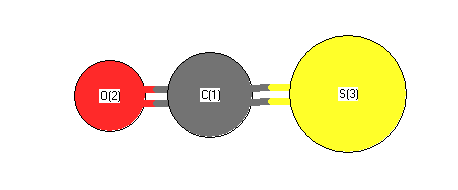Vibrational Frequencies calculated at MP2=FULL/6-31+G**
| Mode Number |
Symmetry |
Frequency
(cm-1) |
Scaled Frequency
(cm-1) |
IR Intensities
(km mol-1) |
Raman Act
(Å4/u) |
Dep P |
Dep U |
|---|
| 1 |
Σ |
2089 |
1962 |
650.36 |
27.29 |
0.55 |
0.71 |
| 2 |
Σ |
902 |
848 |
6.00 |
38.41 |
0.19 |
0.32 |
| 3 |
Π |
494 |
464 |
1.37 |
1.35 |
0.75 |
0.86 |
| 3 |
Π |
494 |
464 |
1.37 |
1.35 |
0.75 |
0.86 |
Unscaled Zero Point Vibrational Energy (zpe) 1989.0 cm
-1
Scaled (by 0.9392) Zero Point Vibrational Energy (zpe) 1868.1 cm
-1
See section
III.C.1 List or set vibrational scaling factors
to change the scale factors used here.
See section
III.C.2
Calculate a vibrational scaling factor for a given set of molecules
to determine the least squares best scaling factor.
